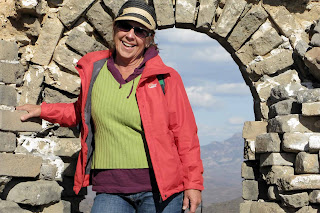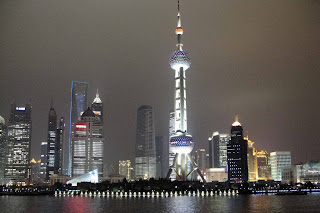The Chinese people: some traditional amidst many of the ultra-contemporary in the BOOMING economy of China today. In the cities of Hong Kong, Beijing, and Shanghai there are fashion districts with Gucci, Chanel, Armani, Armani Jr., and all the other designer names.
Bright lights, skyscrapers, terrible traffic from all the automobiles, overhead expressways winding through the daring architecture, and evidence everywhere of the rising middle class.

An elderly couple having tea and a picnic dinner at a pavilion in one of the classic gardens.





Our 3-day Tour Guide Lucia works for a national (governmental) agency. She is smart, hip, enthusiastic, and always 'says the right thing.' These tour guides are very knowledgable, having to pass a strident exam every 3 years with the real possibility of being permanently discharged if they miss 10 points from either incorrect answers or complaints. One Tour Guide has bought the license to have a second child ($15,000) and another Guide is contemplating buying and paying taxes for a Mini Cooper car ($75,000).

A Pepsi salesman on The Great Wall.
On The Wall we actually encountered traditional peasant class Chinese with broken English and, generally, big smiles!
Chinese fashion models in a photo shoot.
Working for a tea house, this woman demonstrated versions of the traditional Chinese tea ceremonies - all with the intention of selling tea, tea pots, and other tea stuff.
Hiking The Great Wall of China!
600 years ago the Ming dynasty completed 6350 km. = 4000 miles (built 1368-1644). The Wall was constructed to guard against the Mongols in the NE of China. Human power built this marvel that can actually be seen from outer space. If one were to walk it today, all day, every day, it would take 1 1/2 years. The going is not swift!
Along with 60 Semester-as-Sea students, Faculty, and Life Long Learners, we hiked the Great Wall for two days, and it was exhilarating!


For one long section we left the Wall because "it is a military post" and walked overland, traversed a section of terraced but barren farmland, proceeded past an old abandoned farmer's house, and crawled back up onto the wall. This photo demonstrates how steep down and up some of the section are! Sometimes it was necessary to scramble up broken-away stairs on hands and feet. Sometimes it was necessary to sit on my bottom and reach my feet out for the next foothold.

Looking back mid-way through the first morning: we began our hike way over there by the road along one of the un-reconstructed parts of the Wall. We walked single file because sometimes the trail was only 14"-16" wide with steep slopes or drop-offs on one or both sides.
Sometimes it was scary and all I could do was look down at the trail right in front of me.
In my journal that night I wrote: "Steeper, rockier, more precarious and colder than I'd predicted. Through lack of foresight I had no gloves nor hat (save my stylin' Heathrow Airport Cap). Used Nancy Carr's extra socks for mittens. Sometimes I clamped the hood of my great 'Hot Tomato' Coretex jacket, esp. when my cap might blow away from the wind. Footing was always an issue and when I tired I was concerned that I would take a mis-step. At first the pace was quick led by the "mountain goat" Chinese woman in a hot pink jacket, but they gave us ample rest stops, sometimes just standing, resting, in a long row on a ridge, other times, just crouched in a warm sunny spot."


That part is DIFFICULT and can only be done with both hands and feet!

That part is STEEP!

Here is the Chinese woman who picked me out to help over rubble, steep spots, and difficult
trails

On the Wall are the hikers and coming up the dirt trail is a Chinese person coming to work the Wall - helping people, selling drinks, and selling trinkets (for inflated prices - but, hey, what 'cha gonna do!). Some of these Wall workers told us they walk 2 hours to home and all of them who spoke some bits of English told us they are farmers.

Look all the way to the farthest watchtower visible - that was was our destination on day 2 - and then we walked down thousands (literally) of steps to get back to the tent latrines (brrr...) and the bus.

As the sun set at the end of the first day I was cold and weary, taking care to place each footfall carefully so I would not only be the oldest of the hiking group but also the only one to fall off the Wall!

Gardens

Founded over 2500 years ago, Suzhou, today a 'small' city of only 10 million an hour outside of Toyko, was the traditional city of gardens and canals for aristocrats. We visited
Tiger Hill with it's leaning Yunyan Pagoda, a tomb tomb for the king. We visited
The Garden of the Humble Administrator and also
The Garden of the Master of the Nets, both beautiful classic Chinese gardens with water, bonzai, rocks, and buildings.


During the centuries of Imperial China, the color red was considered lucky. Yellow represented the earth and to wear yellow was forbidden for common people..... at penalty of loosing one's head.

The Forbidden City, aligned on a N/S access in keeping with Chinese fung shui (which allows the energy to enter E/W from the mountains) is a series of gates and courtyards and inner courtyards. In the center are the Imperial residence and Imperial Garden where the Last Emperor, a boy, was allowed to live after 1911 when Sun Yat-Sen took over from the last Qing Dynasty. The boy Emperor was chosen by the infamous Empress Dowager (.... see The Last Emperor)

The Gate of Supreme Harmony
The Imperial Palace of the Forbidden City, Beijing
Imagine freezing COLD temperatures with a brisk wind, which made the
visit to the Forbidden City more of a quick walk than a casual stroll!



Beijing: listed at 15 million but the Chinese tell us just under 20 million people, busy, clean and orderly, many parks, skyscrapers and more skyscrapers, traditional China enclaves nestled into contemporary China, tourists, Tiananman Square, the Foridden City, 60 km access to The Great Wall. Traffic congestion is bad so every day certain cars may not drive based on the last number of the license tag. Just about every photo taken shows a layer of pollution in the sky.
Shanghai: 4500 skyscrapers over 20 stories in the last 20 years; population 20 million but they regularly mention 24 million, traffic, commerce, developing middle class, lights, daring architecture, technology, people, and did I say traffic! Just 10+ years ago the predominant vehicle was the bicycle but
not today. The streets are jammed with German and Japanese cars: BMW, VW, Audi, Honda, Toyota, plus Buicks! The import tax is 30% over the price and the limited vehicle tag auctions begin at $9000. Cars from outside Shanghai may NOT drive in the city during rush hours.





City lights: leaving Shanghai harbor



 Looking back mid-way through the first morning: we began our hike way over there by the road along one of the un-reconstructed parts of the Wall. We walked single file because sometimes the trail was only 14"-16" wide with steep slopes or drop-offs on one or both sides.
Looking back mid-way through the first morning: we began our hike way over there by the road along one of the un-reconstructed parts of the Wall. We walked single file because sometimes the trail was only 14"-16" wide with steep slopes or drop-offs on one or both sides. 












 Beijing: listed at 15 million but the Chinese tell us just under 20 million people, busy, clean and orderly, many parks, skyscrapers and more skyscrapers, traditional China enclaves nestled into contemporary China, tourists, Tiananman Square, the Foridden City, 60 km access to The Great Wall. Traffic congestion is bad so every day certain cars may not drive based on the last number of the license tag. Just about every photo taken shows a layer of pollution in the sky.
Beijing: listed at 15 million but the Chinese tell us just under 20 million people, busy, clean and orderly, many parks, skyscrapers and more skyscrapers, traditional China enclaves nestled into contemporary China, tourists, Tiananman Square, the Foridden City, 60 km access to The Great Wall. Traffic congestion is bad so every day certain cars may not drive based on the last number of the license tag. Just about every photo taken shows a layer of pollution in the sky.
















No comments:
Post a Comment